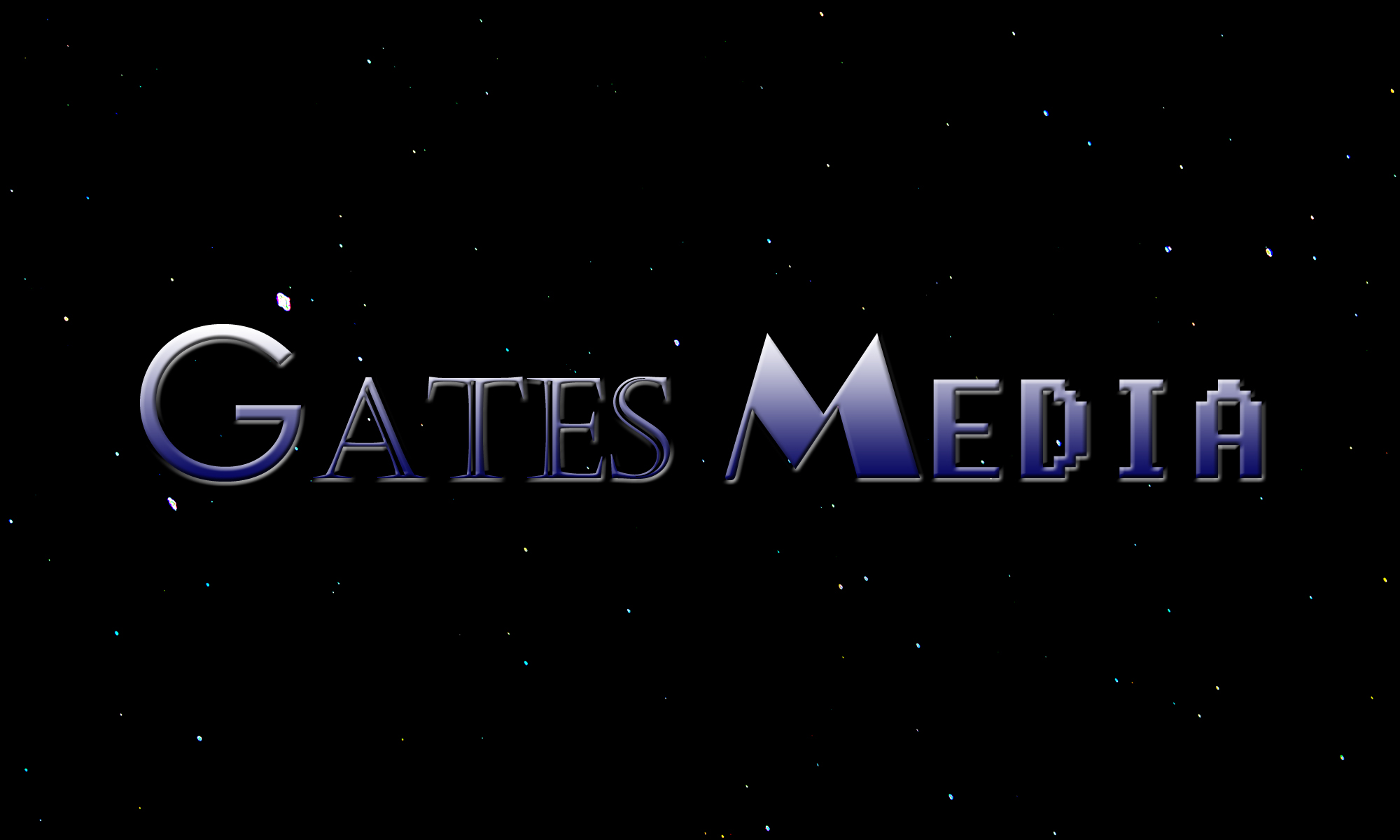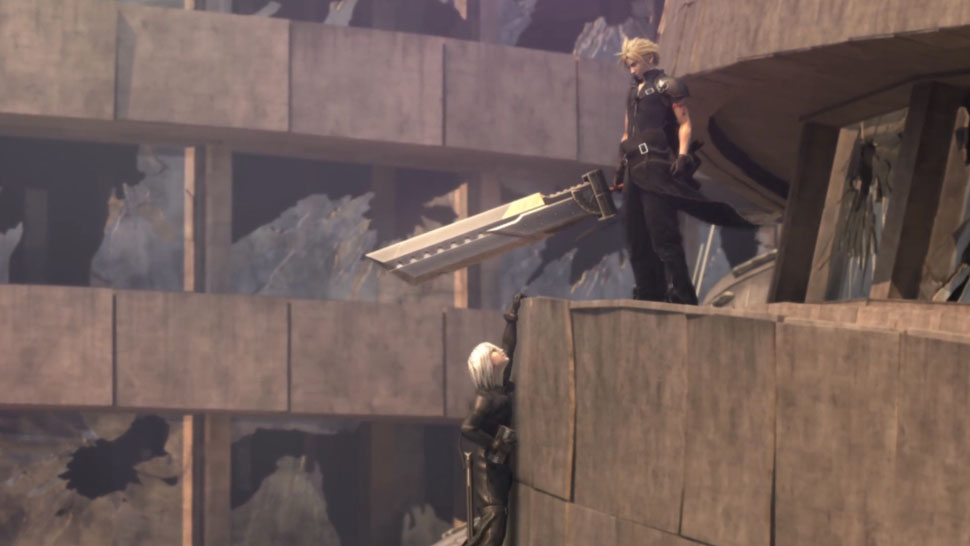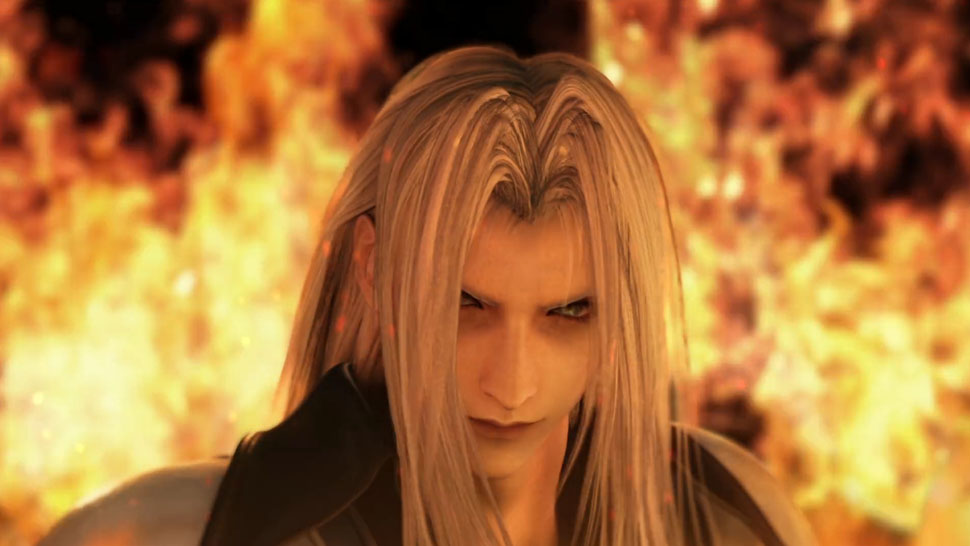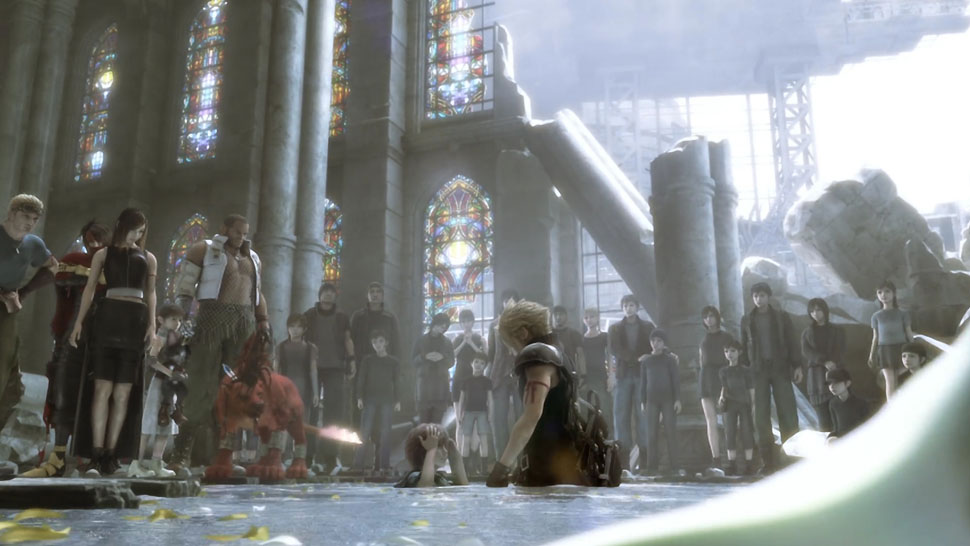| Part 1 | Part 2 | Part 3 |
Originally published on the Extra Life Community website
Edited by Jack Gardner
I always took it for granted that I couldn’t defend my illogical love for Final Fantasy VII: Advent Children. I didn’t even complete a Final Fantasy game until after I saw Advent Children. I was an aspiring writer with a guilty pleasure; I enjoyed a movie that had a nonsense plot and weak characters. Half the Internet labeled me a fangirl, pining after meaningless action scenes, technology porn, effeminate men in black leather, and an emo protagonist. The other half of the Internet, however, loved the movie as much as I did, but no one could defend why, besides citing its obviously spectacular visuals, action, and music.
Then, in 2013, I asked myself, “Why do I like Advent Children?” It had been my favorite movie for eight years. I’d just graduated with a bachelor’s degree in media arts. Five years of studying filmmaking and films praised as the greatest ever made had failed to dislodge a video game-based, action movie from its prestigious place in my mind. In the wake of Avatar, Pixar movies, films receiving rave reviews, Advent Children remained. The nostalgia glasses, if they even existed, refused to fall off. After all this, I wondered why I should continue to accept that Advent Children didn’t mean anything.
I began a journey of self-discovery to find the most action-packed, realistic, adult, and oddball movies CGI had to offer. Even before Advent Children, computer animation had fascinated me. As a kid, I watched A Bug’s Life until I could recite every line. I loved pre-rendered video game cutscenes, particularly from the Oddworld series. Surely, if I liked Advent Children only for the graphics, I should like Final Fantasy: The Spirits Within. If I liked its action and PG-13 rating, then I should like Beowulf. If I liked its originality, then I should like a CGI movie with an original story like Vexille. From the mainstream 9, The Polar Express, and Kingsglaive: Final Fantasy XV to the lesser-known Elysium, Tekken: Blood Vengeance, and Kaena: The Prophecy to the cell-shaded Japanese imports Appleseed and Dragon Age: Dawn of the Seeker, I’ve watched them all, as many as I could find. While I found each of them beautiful in their own way, none of them affected me as profoundly as Advent Children had. I began tearing them apart to figure out how they worked or didn’t work. Each film taught me a little more about Advent Children until I finally understood it.
Contrary to what almost every reviewer says, Advent Children contains a complete and masterfully told story; its greatest weakness and greatest strength lies in subtlety. As an action movie, Advent Children builds its world, develops its characters, and tells its story with action. Believe it or not, its stunning cinematography and fight scenes contain a wealth of information in addition to looking flashy. The film’s visuals and short but to-the-point dialog contain everything we need to know to understand the story and characters. As expected, this visual and minimalist storytelling requires the viewer’s attention. Fortunately, its beautiful artwork encourages multiple viewings to absorb the details.
Unfortunately, misconceptions of Advent Children often result in critics prematurely discarding it and unfairly describing it. Non-fans of Final Fantasy VII discard it as incomprehensible on the assumption that the story exists in the game or not at all when it is really in the frame. Fans discard it without examining its merits because it sequels a story that didn’t need one or has too much or not enough fan service.
A film based in the Final Fantasy VII universe must exist solely for fans.
An action movie that defies physics must not have any rules.
This film is a visual spectacle; therefore, it must not contain thoughtful content.
Advent Children is just an unrealistic cartoon that shouldn’t be treated seriously.
In truth, Advent Children defies the stereotypes of every label applied to it: fan service film, video game movie, photorealistic CGI, cartoon CGI, action movie, original science-fiction story, etc. The film is all of these things and none of them. It achieves something completely unique that has never been done so well by any other CGI movie. It tells a dark, thoughtful, and human story with computer graphics. Advent Children is a work of art disguised and discarded as fan service.
At a glance, Advent Children appears to have spectacular action, emo characters, and no sensible plot, but closer examination reveals the film’s universal story and devastatingly human characters. Reviewers say that Advent Children’s convoluted, nonsense plot exists only to tie together its action scenes and that only Final Fantasy VII fans can understand it. While the story that defines Advent Children’s setting is somewhat complex and heavy with Final Fantasy VII concepts, the protagonist’s story isn’t, and the movie provides enough details that anyone can follow along.
Two years ago, a super-soldier named Sephiroth attempted to destroy the planet as revenge for the experiments that made him. The Shinra Power Company created him among a special group of warriors known as SOLDIER to defend itself against rebels who disagreed with their transformation of the planet’s life force, known as the Lifestream, into energy. To give them strength, Shinra infected its warriors with the cells of Jenova, an alien being that caused a catastrophe long ago.
A group of rebels, the film’s protagonist Cloud among them, and the Lifestream itself managed to stop Sephiroth, but two years later, not all is well. A terminal illness called geostigma sweeps through the population, and three mysterious figures, Kadaj, Yazoo, and Loz, appear. Their leader Kadaj reveals that those with geostigma inherited Jenova’s power and will to destroy the planet just as Sephiroth did. Kadaj claims that they need cells from Jenova’s remains to fulfill this prophecy, and he believes that Shinra holds them in their possession. Since the destruction of Shira’s power plant, only its president Rufus and a handful of employees, Reno, Rude, Elena, and Tseung, remain. When Rufus refuses to cooperate, the search for Jenova, which Kadaj and his brothers call Mother, turns to a monument erected by Shinra. Using materia, spheres forged in the Lifestream that allow users to perform magic, Kadaj summons a monster called Bahamut to destroy the monument. After they search the rubble to no avail, Rufus reveals that he holds the remains in his personal possession. He finds the periodic cycle of attempts to destroy the planet amusing because they all inevitably fail. To taunt Kadaj, he tosses the remains away. Kadaj manages to save some of the cells and uses them to become Sephiroth reincarnate.
This may sound like something only the most dedicated of Final Fantasy VII fans would care about, but like the convoluted plots of most Final Fantasy games, this alien story serves as the setting for a much more human tale. Despite fighting alongside those who saved the world two years ago, the protagonist Cloud can’t forget the people who died along the way, especially his mentor Zack and his friend Aerith. He made a promise to Zack that he would live out both their lives, and he wants to make up for his failure to protect Aerith. But now it seems he will not be able to do either. After contracting geostigma, Cloud retreats from his friends and makeshift family, believing that he will die as a worthless person. He can’t even save his foster son Denzel, who has also contracted the disease.
Yazoo and Loz interrupt Cloud’s plans for a quiet death when they attack him out of nowhere. Shinra also offers him an opportunity to help them deal with the three violent teenagers. Initially, Cloud refuses, remembering the company’s questionable business practices, but he’s eventually forced into the conflict when the trio kidnaps Denzel and his friend’s daughter Marlene. Cloud’s attempt to free them ends in failure, but Marlene manages to escape. After receiving a lecture from Marlene and his friends Tifa and Vincent, Cloud formally decides to make an effort to live and seek forgiveness. In response to his newfound determination, Aerith, who has become a god-like being in the afterlife, reveals to him the cure for geostigma, water infused with the Lifestream. The fight to stop Kadaj’s malevolent plot goes well until Cloud finds himself again alone and facing the worst of his past: Sephiroth. Thoughts of those he wishes to protect, however, empower him to finish the fight and save the world. In the end, surrounded by the people he’s saved, Cloud accepts the opportunity to heal his foster son’s geostigma himself.
Yes, Advent Children is about a guy struggling to process his past and find his place in the present, but herein lies the major source of discontent about the film’s characters. Many people complain about the film’s focus on Cloud, his angst-ridden teenager personality, and the lack of development or presence of other characters from the game or otherwise. These complaints have some merit, but as is, Cloud’s surprisingly human character colors the entire film, its characters, its themes, and its battles. Cloud is a fascinating choice of protagonist particularly for a CGI action movie, a medium proliferated with seemingly invincible protagonists that can’t even be hindered by their own supposed weaknesses. Cloud is beyond physically strong as expected but otherwise incredibly flawed. He’s mentally scarred, physically ill, easily exhausted, and emotionally distraught. These problems constantly plague him in his fight to save himself and the world. Images from his past haunt him, pain and exhaustion collapses him, and fear alienates him. He saved the world two years ago only to be struck down by an incurable disease. He can jump super high and wield swords as tall and wide as himself, but a gunshot and a stab wound threaten to kill him at the end of the movie. Forget about fighting the bad guys; he struggles to find the strength to fight. Cloud possesses inhuman abilities but retains human weaknesses.
Cloud evokes real-life mental illnesses like depression, anxiety, OCD, and PTSD. He saved the world and no one blames him for the people who died, but he still sees himself as a failure. Despite his physical strength, he doubts his fighting abilities. Like people with depression, Cloud rejects or fails to internalize his successes and good qualities. He lives in a world that doesn’t need soldiers anymore, but he operates a delivery service with a motorcycle that has built-in sword racks as if the fight two years ago never ended. Intrusive flashbacks of enemies he once fought and people he lost plague him. These symptoms seem like PTSD. Aerith watches over him as a god-like presence and persistent reassurance that everything will be okay. He’s surrounded by friends who adore him and want to help him. But Cloud remains afraid that someone else will die and uncertain in his abilities like someone with anxiety or OCD, who can’t shake the feeling that something is wrong. He chooses loneliness and death at the start of the movie because he’s tired of hurting and doesn’t believe that anyone should care about him. Tifa and Marlene’s frustration with him mirrors the frustration and helplessness felt by loved ones of the mentally ill. Despite the fantastical world that Cloud lives in, he faces some of the most devastating and common of human problems.
Cloud doesn’t just experience sadness and anxiety though. Like most people with or without mental illness, he experiences a range of emotions like embarrassment, happiness, frustration, cockiness, impatience, disgust, relief, and determination. Cloud feels and talks about sadness and anxiety most often, but emotes much more when he deals with enemies, particularly in the heat of battle. This makes sense. Enemies pose a physical threat that Cloud knows how to handle. To varying degrees of success, he can fight physical problems to escape his seemingly unsolvable inner torment. Sometimes fighting only makes him more scared, but when it works, he can feel something other than sadness and fear. Cloud snarls angrily when Loz taunts him. He smiles cockily when his friends let him deal with Kadaj alone. He squints in disgust when Reno mentions resurrecting Shinra. He grimaces with determination as he and Kadaj slide down a rocky hill, but when he slides to a stop and Kadaj pulls ahead, his face returns to a moody frown. The reaction shots in the film round out Cloud as a person.
By melding its somewhat convoluted geostigma-Jenova-Sephiroth plot with Cloud’s story, the film invites interpretation. For me, much of it is about mental illness, which I’ve dealt with most of my life. Kadaj and Cloud explore methods of coping with mental illness. In the beginning of the movie, Cloud chooses to hide his pain and isolate himself from others. Meanwhile, Kadaj, a child damaged and angry from love he never received, chooses to inflict his pain on others and seek companionship. Under the guise that he will heal them, Kadaj seeks out orphans infected with Jenova cells, the closest that he can get to his Mother. He instead indoctrinates them with his own hatred for the world. As the movie progresses, Cloud decides to face his pain in the hopes of healing and reunite with his friends. Kadaj allows his pain to control him and seeks isolation. While Cloud allows Aerith and his friends to heal and strengthen him, Kadaj rejects healing and embraces his pain, seeking solitude with Jenova’s dead remains. Eventually, he allows his hatred to consume him and becomes Sephiroth, a murderer as opposed to a mere torturer. Ultimately, Cloud chooses to live, and Kadaj chooses to die.
For most of the movie, Cloud appears to always be alone while Kadaj bares the appearance that he always has company, but this doesn’t reflect their true states. In every scene, the audience sees Cloud listening to his friends over the phone, receiving divine assistance from Aerith, or accepting help and support from his allies. He feels alone, but he’s never really alone. It takes him most of the film to realize this himself. Meanwhile, Kadaj surrounds himself with children who obey his will, hostages who ultimately betray him, and dead alien remains. Despite all his talk about family, Kadaj wants to be his Mother’s only child and is essentially always alone with only himself for friendly company. Even when he’s with Loz and Yazoo, the three of them comprise the remnants of one person: Sephiroth. Only at the end of the film do we see Kadaj as alone as he is in reality.
Other themes that run through the movie include life, the cycle of life and death, and reunion. For how many action scenes the film contains, it shows surprisingly little blood, gore, and death. All the side and main characters live except for Kadaj, Loz, and Yazoo. Even Sephiroth lives. The film doesn’t glamorize the deaths and injuries onscreen from a monster attack on the city or geostigma. It acknowledges that people die and get hurt, but focuses on showing that more people live as if to say, “Yes, bad things happen, but it’s not the end of the world.” Cloud’s survival at the end of the movie doesn’t mean he solved all his problems. Sephiroth survives, symbolizing that the cycle of life and death, happiness and sadness will continue. For now, Cloud averted the crisis. Perhaps someday, another problem will drag him down, but it will get better again as long as life continues.
Despite all the battles he fights, violence doesn’t heal Cloud; reuniting with people does. Violence damaged him, and it almost kills him at the end of the movie. The kind acts Cloud performs throughout the film lead him to a reunion with his family, his friends, the people of the world, and finally happiness. Cloud discovers Tifa after she loses a fight to Loz. Holding her reminds him of the family he left behind. When he takes Marlene home after she escapes Kadaj’s gang, he returns to his friends to fight alongside them. Cloud sits with Kadaj as he dies, and they both share a sense of relief with the city’s inhabitants when healing rain sent from Aerith falls from the sky. Finally, after Cloud heals Denzel, he glimpses Aerith, walking among the living once again. Seeing her restores his faith and happiness.
Even someone as flawed and damaged as Cloud can survive, find strength, and feel happiness. Perhaps he’ll never be able to do this without his friends, but that’s okay. These messages may sound cheesy, but they can be important to say for those who suffer from mental illness and other adversities where seeing the good things in life is so difficult. I could go on and on about Denzel, family, the salvation of children, and the film’s occasionally bizarre imagery. Final Fantasy VII fans such as Glenn Morrow, Il Neige, and Jirard Khalil have analyzed the film to find meaning through their experiences with the game as well, but I’d better stop here because in an hour and a half, this movie speaks volumes.
Despite what reviewers say, Advent Children clearly has a story with conflicts, characters, and themes that relate to real-world human experiences. While critics may suspect or even recognize that the film has these elements though, they continue that how the film tells this story is the problem. Its excessive fight scenes and short, badly-written dialog hints that novice filmmakers padded a short film with an hour of senseless but cool-looking fight scenes. Are the battles really pointless distractions though? Part two of this three-part series will reveal the genius behind Advent Children’s action-packed madness.






